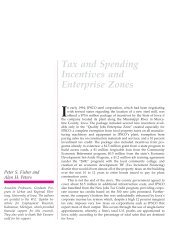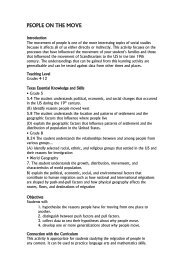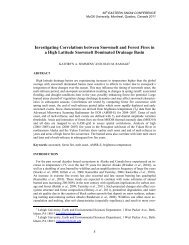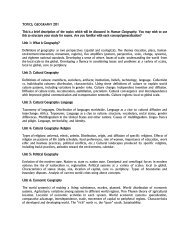Texas Social Studies Framework - Department of Geography ...
Texas Social Studies Framework - Department of Geography ...
Texas Social Studies Framework - Department of Geography ...
Create successful ePaper yourself
Turn your PDF publications into a flip-book with our unique Google optimized e-Paper software.
Chapter 5: The Teaching-Learning System: Curriculum, Instruction, and Assessment<br />
Figure 33: Aligning Curriculum, Instruction, and Assessment:<br />
U.S. Government<br />
TEKS 3 History. The student understands the roles played by individuals, political parties, interest groups,<br />
and the media in the U.S. political system, past and present.<br />
(A) give examples <strong>of</strong> the processes used by individuals, political parties, interest groups, or the media<br />
to affect public policy; and<br />
65<br />
65<br />
(B) analyze the impact <strong>of</strong> political changes brought about by individuals, political parties, interest groups,<br />
or the media, past and present.<br />
Curriculum: The curriculum identifies what the student will know, understand, and be able to do related to the<br />
idea <strong>of</strong> the roles played by individuals, political parties, interest groups, and the media. Knowledge: The student<br />
will recall information: the processes used by individuals and other special interest groups to affect public policy.<br />
Understanding: The student will analyze the ways individuals, parties, and interest groups influence political<br />
change. Application: Students will demonstrate an understanding <strong>of</strong> the ways they can influence political change<br />
(TEKS 16 A and 23 A).<br />
Instruction: Instruction focuses student learning and activity on the curriculum. Knowledge: Students will<br />
identify the opinions expressed by individuals, political parties, interest groups, and the media about one public<br />
policy issue. They will identify the different processes and products each group generated and analyze the<br />
message contained in each. Understanding: Students will participate in a role playing exercise in which they<br />
interpret the opinions <strong>of</strong> a character that believes differently than the student about an issue. Application: The<br />
student will devise a strategy to influence public policy from a given perspective.<br />
Assessment: Assessment provides evidence <strong>of</strong> how well students know, understand, and are able to apply the<br />
curriculum. Knowledge: At the end <strong>of</strong> a lesson on the role individuals, political parties, and special interest groups<br />
play in the U.S. political system, students will complete fill-in-the-blank responses or short answer essays that<br />
assess their knowledge <strong>of</strong> the ways individuals, groups, and the media affect public policy. Understanding:<br />
Students will compare the stand a political party or a right-to-life group takes toward capital punishment and the<br />
different processes each uses to influence public policy about that issue. Students will explain the differences.<br />
This moves student understanding beyond simple recall through application and perspective (See Figure 25).<br />
Application: Building on the role playing exercise, students will adopt a perspective and will create a brochure,<br />
media presentation, or petition that would generate support for a public policy issue. They will also explain how<br />
the actions <strong>of</strong> special interest groups influence their self-knowledge (Figure 25, Empathy, Self-Knowledge).
















